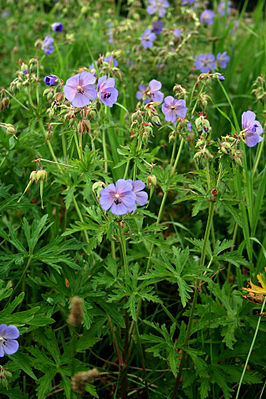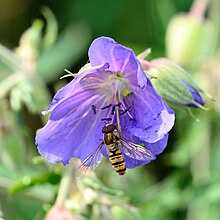Meadow cranesbill
| Meadow cranesbill | ||||||||||||
|---|---|---|---|---|---|---|---|---|---|---|---|---|

Meadow cranesbill ( Geranium pratense ) |
||||||||||||
| Systematics | ||||||||||||
|
||||||||||||
| Scientific name | ||||||||||||
| Geranium pratense | ||||||||||||
| L. |
The Meadow cranesbill ( Geranium pratense ), and Blue beak herb is a species of the genus of geranium ( Geranium ) in the family of geraniaceae (Geraniaceae).
features
The meadow cranesbill is a perennial herbaceous plant that reaches heights of 20 to 80 centimeters. It is a deciduous hemicryptophyte . On the stem and on the petioles there are downward hairs, especially the upper part and the flower stalks are hairy glandular. The opposite leaves are petiolate. The leaf blades are deeply hand-shaped, their seven sections are pinnately fissured and deeply serrate. Stipules are present.
The flowers are arranged in pairs. The flower stalks are bent downwards after they have withered, and often straightened up again in the end. The hermaphrodite flower is radially symmetrical and five-fold. The five green sepals are (0.7 to) usually 1 to 1.2 cm long. The five light blue-violet petals are around 15 to 22 millimeters long. There are two circles with five stamens each. The stamens are abruptly triangular at the base, usually 1.5 to 2 mm wide. Five carpels have become a top permanent ovary grown. The stylus are 5 to 8 mm long. The fruit is 3 to 3.7 cm long. The fruit valves are densely hairy.

The flowering period extends from June to August. The number of chromosomes is n = 14, or 2n = 28.
The flower formula is:
ecology
The meadow cranesbill is a perennial hemicryptophyte and a half-rosette plant. Because of leaf joints, the plants can on other larger species than Spreizklimmer support. With the help of the leaf joints, an exact alignment of the leaf surface towards the greatest incidence of light is possible; this happens due to photonasty . The plant is also richly glandular and shaggy due to its scalp hairs with essential oils. It also has a strong rhizome .
The flowers are strictly pre-male "nectar-bearing disc flowers". Your nectar is protected by a wreath of hair as a "layer of juice". First the inner, then the outer stamens spread and finally the scar branches. In addition to hermaphrodite plants, it is not uncommon for all-female plants with small flowers to be found. So the species is gyno-dioecious. The glandular hairs on the stem, which is bent down after flowering, are intended to keep insects crawling upwards as unwanted visitors. The lifespan of the flowers is 2 days. Pollinators are especially bees and hoverflies , and more rarely butterflies . The species is an important bee pasture in the summer months and the beginning of autumn. A self-pollination is almost excluded. The flowering period extends from June to August.
The fruits are desiccant spreaders. The seed lies loosely in the cup-shaped lower part of the fruit compartment. It is prevented from falling out prematurely by protrusions or hairs. If the fruit fans suddenly detach from the central column, the seeds are thrown away like a catapult up to over 2 m. For this purpose, people spread through displacement with the mowing material. The seeds are cold germs .
Occurrence
The meadow cranesbill occurs in Europe and Asia in the meridional to boreal climatic zone. It has its main occurrence on nutrient-rich, mostly calcareous fresh meadows and pastures, its secondary occurrence in nutrient-rich herbaceous and perennial weeds. It is a character type of the Arrhenatheretum, but also occurs in societies of the Alliarion association.
According to Dörr and Lippert, the species spread rapidly along the traffic routes in the Allgäu after 1960 and is now widespread there. It rises there in the Alps in Bavaria on the lower Wengenalpe in the Hintersteiner Valley up to 1230 m above sea level.
literature
- Eckehart J. Jäger (Ed.): Rothmaler excursion flora of Germany. Volume 2: Vascular Plants: Basic Volume. Spektrum Akademischer Verlag, Munich 2005, ISBN 3-8274-1600-0 .
- Ruprecht Düll , Herfried Kutzelnigg : Pocket dictionary of plants in Germany and neighboring countries. The most common Central European species in portrait. 7th, corrected and enlarged edition. Quelle & Meyer, Wiebelsheim 2011, ISBN 978-3-494-01424-1 .
Individual evidence
- ↑ www.floraweb.de
- ^ Erich Oberdorfer : Plant-sociological excursion flora for Germany and neighboring areas. 8th edition. Stuttgart, Verlag Eugen Ulmer, 2001. Page 625. ISBN 3-8001-3131-5 .
- ↑ Erhard Dörr, Wolfgang Lippert : Flora of the Allgäu and its surroundings. Volume 2, IHW, Eching 2004, ISBN 3-930167-61-1 , pp. 167-168.
Web links
- Geranium pratense. In: FloraWeb.de.
- Profile and distribution map for Bavaria . In: Botanical Information Hub of Bavaria .
- Geranium pratense L. In: Info Flora , the national data and information center for Swiss flora . Retrieved November 28, 2015.
- Distribution in the northern hemisphere according to: Eric Hultén , Magnus Fries: Atlas of North European vascular plants 1986, ISBN 3-87429-263-0
- Thomas Meyer: Data sheet with identification key and photos at Flora-de: Flora von Deutschland (old name of the website: Flowers in Swabia )
- Description in the Flora of China. (English)
- Entry in Plants for a Future. (English)
- Characteristics.
- Description of Geranium pratense ssp. stewartianum Y.Nasir in the Flora of Pakistan. (English)





